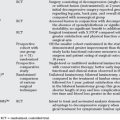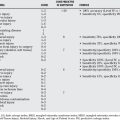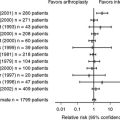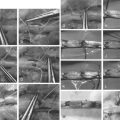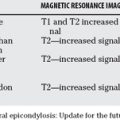Chapter 20 What Is the Best Treatment for Complex Proximal Humerus Fractures? What Are the Main Determinants of Outcome after Arthroplasty?
Proximal humerus fractures account for 4% to 5% of all fractures.1 The majority of proximal humerus fractures (approximately 80%) are minimally displaced and can be treated with a sling and early mobilization.2 Two-part fractures are most often treated with some form of osteosynthesis. Frequently, attempts to preserve the proximal humerus are also made in young, active patients with good bone quality who have three-part and valgus-impacted four-part fractures (level V). Osteosynthesis is usually considered preferable to hemiarthroplasty in young patients (level V) because of concerns about glenoid wear and implant longevity.3–5
Certain complex proximal humerus fractures, however, are either not amenable to fixation or are at significant risk for humeral head osteonecrosis, making osteosynthesis a less desirable option. These include widely displaced four-part fractures and fracture dislocations, head-splitting fractures with greater than 40% articular surface involvement, anatomic neck fractures, and selected three-part fractures in patients with osteopenia and nondisplaced comminution that precludes secure internal fixation.6 In these cases where the risk for fixation failure is high, humeral head replacement is generally accepted as the best option. Support for this philosophy comes from the fact that primary hemiarthroplasties are technically easier and have been consistently shown in retrospective comparative series to have better outcomes than secondary hemiarthroplasties performed for failed internal fixation or nonoperative treatment.7–11
The literature on prosthetic treatment of complex proximal humerus fractures is sparse. Only three level I or II studies currently exist: one compares hemiarthroplasty with nonoperative treatment,12 whereas the other two compare hemiarthroplasty with tension band wiring.13,14
In 1984, Stableforth12 conducted a prospective, randomized, nonblinded comparison of uncemented hemiarthroplasty and nonoperative treatment. His study included 32 patients with an average age of 67 who had four-part proximal humerus fractures. The author found a significant reduction in pain, improved range of motion and strength, and greater ability to perform activities of daily living in patients treated with hemiarthroplasty. Criticisms of this limited study include its variable and relatively short follow-up period, unclear method of randomization, and poorly defined outcome measurements.15
In 1997, Hoellen and colleagues13 compared hemiarthroplasty with open reduction and tension band wiring in a randomized, controlled trial of 30 patients, older than 65 years, with 4-part fractures. One-year follow-up was available for only 18 of the 30 patients. Results in the two groups were comparable with respect to pain, function, and ability to perform activities of daily living. The most significant difference between the two groups was that none of the patients in the arthroplasty group required reoperation, were five patients in the fixation group required further surgery for wire displacement (four patients) or failed fixation (one patient).
Two years after the study by Hoellen and colleagues,13 Holbein and coworkers14 published a follow-up report. This subsequent study included 39 patients with both 3- and 4-part fractures with up to 2-year follow-up. One-year data were available for 31 patients with 2-year follow-up for 24 patients. The results of this study were similar to those that Hoellen and colleagues13 reported. The authors found no significant difference in patients with three- or four-part fractures treated with either tension band wiring or arthroplasty. At 2-year follow-up, however, nine patients in the fixation group required further surgery compared with none in the hemiarthroplasty group. It is difficult to make any sound conclusions from these studies because of the short follow-up period and significant dropout rate. The generalizability of these findings to younger patients is also unclear.
In 2003, Handoll and coworkers15 conducted a Cochrane review on the treatment of proximal humerus fractures in adults. Based on their analysis, they were unable to provide any treatment recommendation. Both Bondi and coauthors16 and Bhandari and investigators,17 after systematic evidence-based reviews on proximal humerus fractures, also found insufficient evidence from randomized trials to determine optimal treatment. They conclude that until valid evidence exists, the management of proximal humerus fractures will be based on surgeon preference, ability, and experience. Although evidence-based support for arthroplasty in the treatment of complex proximal humerus fractures is lacking, some evidence exists that arthroplasty can optimize patient outcomes once the decision to treat has been made.
RESULTS AFTER HUMERAL HEAD REPLACEMENT
Reliable pain relief, patient satisfaction, and reasonable implant longevity have been consistently demonstrated in multiple retrospective reviews of patients who underwent hemiarthroplasty for complex proximal humerus fractures. Good-to-excellent pain relief has been reported in 73% to 97% of patients; overall, more than 80% of patients expressed satisfaction with their treatment, and prosthesis survival at 10 years ranges from 83% to 94%.18
PREOPERATIVE FACTORS
Robinson and investigators19 performed a level II observational cohort study of 163 patients with complex humerus fractures treated with hemiarthroplasty. Of the 163 patients, 25 died or were lost to follow-up within the first postoperative year. The remaining 138 patients with an average age of 68.5 years were evaluated with Constant scores. Using a univariate linear regression model, the authors assessed the factors immediately after injury and at 6 weeks after surgery; these factors were predictive of the Constant score at 1 year.
OPERATIVE AND POSTOPERATIVE FACTORS
Robinson and investigators19 also evaluated factors that affect outcome at 6 weeks after surgery. They found that the factors assessed at 6 weeks after surgery (which were mostly related to surgery) provided a more precise prediction of 1-year outcome than the patient-based factors assessed before surgery. The need for early reoperation, significant displacement of the prosthetic head from the central axis of the glenoid (radiographically), and radiographic evidence of retraction of one or more of the tuberosities were all predictive of worse outcomes. The authors emphasize the importance of an intact, functioning rotator cuff because many of the reoperations were due to displacement of the tuberosities, and subluxation was attributed to an incompetent rotator cuff. Advanced patient age and the presence of a persistent neurologic deficit were also shown to significantly predict poorer Constant scores at 1 year.
Boileau and colleagues,20 in a prospective, multicenter, prognostic, level II study, attempted to determine the clinical and radiographic parameters that contribute to unsatisfactory results in some patients. Using regression tests for correlation, they demonstrate that final outcomes were directly related to tuberosity osteosynthesis. The factors associated with failure of tuberosity osteosynthesis were malpositioning of the greater tuberosity, poor initial position of the prosthesis, and age older than 75 in women.
Tuberosity malpositioning and/or migration, which was found in 50% of patients based on final follow-up radiographs or computed tomographic (CT) scans, was the most significant factor associated with poor outcomes. Malpositioning of the greater tuberosity was defined as greater than 5 mm superior or 10 mm inferior to the superior aspect of the humeral head, or as posterior placement such that the greater tuberosity was not visible on the postoperative anteroposterior radiograph in external or neutral rotation but could be seen on the internal rotation, axillary, scapular lateral, or CT views. Malpositioning of the prosthesis also significantly correlated with both tuberosity malpositioning and significantly worse functional results. Prosthesis malpositioning was defined as greater than 10 mm cephalad, 15 mm caudal, or retroversion of greater than 40 degrees. The negative influence of age on outcome was also confirmed. These authors found that women older than 75 years had a significantly greater failure rate of tuberosity osteosynthesis and subsequently worse outcomes than the other patients in their study. This was most likely due to a greater degree of osteopenia and, therefore, less secure fixation of the tuberosities.
SURGICAL RECOMMENDATIONS
Although patient-related factors are often out of the surgeon’s control, the literature does provide some guidance on avoiding prosthesis malpositioning and attaining secure tuberosity fixation. Reestablishment of the patient’s natural retroversion is difficult in the setting of a proximal humerus fracture. Some authors have suggested using the bicipital groove as a reference point.21–23 By placing the lateral fin of the prosthesis a standard distance from the posterior edge of the bicipital groove, a predictable degree of retroversion can be attained. Several authors, however, have noted wide variations in the degree of humeral retroversion among different patients.24–26 Use of a standard version may therefore result in significant malpositioning of the humeral stem.24–26
Kontakis and researchers,26 in a study using 45 cadaveric specimens, showed that humeral head retroversion varies between 2 6.3 (i.e., anteversion) and 41.7 degrees. They found that placing the humeral prosthesis with the lateral fin at the posterior aspect of the bicipital groove, as commonly suggested, often resulted in excessive retroversion when compared with the patient’s natural version. In some cases, this could lead to overtensioning of the greater tuberosity and ultimately failure of fixation when the arm is rotated internally. Using CT scans of cadaveric proximal humeri, they were able to estimate the natural version and measure the distance that the posterior fin of the prosthesis should be placed from the posterior aspect of the bicipital groove. They were able to use this method on six of their patients by obtaining CT scans of the opposite shoulder before surgery.
Murachovsky and coauthors27 in another cadaveric study found that the pectoralis major tendon is a helpful landmark for restoring correct humeral height. After dissection of 40 shoulders, they found the distance from the upper border of the pectoralis major tendon insertion on the humerus to the top of the humeral head was 5.6 ± 0.5 cm with a confidence level of 95%. In addition, they found no correlation between the size of the patient and this measurement. In cases where severe comminution of the proximal humerus makes estimation of the appropriate humeral height difficult, this method may be useful. Other authors have suggested preoperative templating of the opposite side, restoration of the medial calcar, reapproximation of the fracture fragments, or referencing based on the tension of the long head of the biceps to restore humeral height. All of these tools are at the surgeon’s disposal and can be helpful when utilized.
Attaining secure, anatomic tuberosity fixation starts with anatomic positioning of the prosthesis using the tools just described. Correct positioning of the prosthesis makes anatomic positioning of the tuberosities much easier and reduces stress on the repair. Nonanatomic positioning of the greater tuberosity in a cadaveric model has been shown to significantly impair external rotation kinematics and increase torque requirements by eightfold.28 When the tuberosities are anatomically placed, Frankel and coworkers29 have shown that supplementation of the tuberosity repair with a circumferential medial cerclage incorporated into the prosthesis reduces strain on the greater tuberosity by more than 100%.
CONCLUSIONS
Currently, because of a lack of randomized, controlled trials, no recommendations can be made on the optimal treatment of three- and four-part proximal humerus fractures. However, recommendations can be made for optimizing outcomes once the decision to treat with arthroplasty has been made. Younger patients without neurologic deficits who do not smoke or consume alcohol tend to have better outcomes. Patients treated with early primary arthroplasty also have consistently better outcomes than patients who have secondary arthroplasty after failure of nonoperative or operative treatment. The most important factors for optimizing patient outcomes appear to be surgically related. Proper prosthesis positioning and secure anatomic tuberosity fixation lead to more reliable tuberosity osteosynthesis and improved outcome scores. Table 20-1 provides a summary of recommendations for the treatment of humerus fractures.
| STATEMENT | LEVEL OF EVIDENCE/GRADE OF RECOMMENDATION |
|---|---|
B = fair evidence (level II or III studies with consistent findings) for or against recommending intervention;
C = poor-quality evidence (level IV or V with consistent findings) for or against recommending intervention; I = insufficient or conflicting evidence not allowing a recommendation for or against intervention.
1 Horak J, Nilsson BE. Epidemiology of fractures of the upper end of the humerus. Clin Orthop. 1975;112:250-253.
2 Shin SS, Zuckerman JD. One-part fractures. In: Zuckerman JD, Koval KJ, editors. Shoulder Fractures: The Practical Guide to Management. New York: Thieme Medical Publishers; 2005:50.
3 Parsons IM4th, Millett PJ, Warner JJ. Glenoid wear after shoulder hemiarthroplasty: Quantitative radiographic analysis. Clin Orthop Relat Res.; 421; 2004; 120-125.
4 Sperling JW, Cofield RH. Revision total shoulder arthroplasty for the treatment of glenoid arthrosis. J Bone Joint Surg Am. 1998;80:860-867.
5 Sperling JW, Cofield RH, Rowland CM. Neer hemiarthroplasty and Neer total shoulder arthroplasty in patients fifty years old or less. Long-term results. J Bone Joint Surg Am. 1998;80:464-473.
6 Wirth MA. Late sequelae of proximal humerus fractures. Instr Course Lect. 2003;52:13-16.
7 Becker R, Pap G, Machner A, Neumann WH. Strength and motion after hemiarthroplasty in displaced four-fragment fracture of the proximal humerus: 27 patients followed for 1-6 years. Acta Orthop Scand. 2002;73:44-49.
8 Bosch U, Skutek M, Fremerey RW, Tscherne H. Outcome after primary and secondary hemiarthroplasty in elderly patients with fractures of the proximal humerus. J Shoulder Elbow Surg. 1998;7:479-484.
9 Demirhan M, Kilicoglu O, Altinel L, et al. Prognostic factors in prosthetic replacement for acute proximal humerus fractures. J Orthop Trauma. 2003;17:181-188.
10 Moeckel BH, Dines DM, Warren RF, Altchek DW. Modular hemiarthroplasty for fractures of the proximal part of the humerus. J Bone Joint Surg Am. 1992;74:884-889.
11 Frich LH, Sojbjerg JO, Sneppen O. Shoulder arthroplasty in complex acute and chronic proximal humeral fractures. Orthopedics. 1991;14:949-954.
12 Stableforth PG. Four-part fractures of the neck of the humerus. J Bone Joint Surg Br. 1984;66:104-108.
13 Hoellen IP, Bauer G, Holbein O. [Prosthetic humeral head replacement in dislocated humerus multi-fragment fracture in the elderly—an alternative to minimal osteosynthesis?]. Zentralbl Chir. 1997;122:994-1001.
14 Holbein O, Bauer G, Hoellen I, et al. [Is primary endoprosthetic replacement of the humeral head an alternative treatment for comminuted fractures of the proximal humerus in elderly patients?]. Osteosynthese Int. 1999;7(suppl 2):207-210.
15 Handoll HHG, Gibson JNA, Madhok R. Interventions for treating proximal humeral fractures in adults. Cochrane Database Syst Rev. 2003;4:CD000434.
16 Bondi R, Ceccarelli E, Campi S, Padua R. Shoulder arthroplasty for complex proximal humeral fractures. J Orthop Traumatol. 2005;6:57-60.
17 Bhandari M, Matthys G, McKee MD. Evidence-Based Orthopaedic Trauma Working Group: Four part fractures of the proximal humerus. J Orthop Trauma. 2004;18:126-127.
18 Kwon YW, Zuckerman JD. Outcome after treatment of proximal humeral fractures with humeral head replacement. Instr Course Lect. 2005;54:363-369.
19 Robinson CM, Page RS, Hill RM, et al. Primary hemiarthroplasty for treatment of proximal humeral fractures. J Bone Joint Surg Am. 2003;85:1215-1223.
20 Boileau P, Krishnan SG, Tinsi L, et al. Tuberosity malposition and migration: Reasons for poor outcomes after hemiarthroplasty for displaced fractures of the proximal humerus. J Shoulder Elbow Surg. 2002;11:401-412.
21 Tillett E, Smith M, Fulcher M, Shanklin J. Anatomic determination of humeral head retroversion: The relationship of the central axis of the humeral head to the bicipital groove. J Shoulder Elbow Surg. 1993;2:255-256.
22 Bigliani L. Proximal humeral arthroplasty for acute fractures. In: Craig EV, editor. The Shoulder. New York: Raven Press; 1995:259-274.
23 Angibaud L, Zuckerman JD, Flurin PH, et al. Reconstructing proximal humeral fractures using the bicipital groove as a landmark. Clin Orthop. 2007;458:168-174.
24 Kummer FJ, Perkins R, Zuckerman JD. The use of the bicipital groove for alignment of the humeral stem in shoulder arthroplasty. J Shoulder Elbow Surg. 1998;7:144-146.
25 Edelson G. Variations in the retroversion of the humeral head. J Shoulder Elbow Surg. 1999;8:142-145.
26 Kontakis GM, Damilakis J, Christoforakis J, et al. The bicipital groove as a landmark for orientation of the humeral prosthesis in cases of fracture. J Shoulder Elbow Surg. 2001;10:136-139.
27 Murachovsky J, Ikemoto RY, Nascimento LG, et al. Pectoralis major tendon reference (PMT): A new method for accurate restoration of humeral length with hemiarthroplasty for fracture. J Shoulder Elbow Surg. 2006;15:675-678.
28 Frankle MA, Greenwald DP, Markee BA, et al. Biomechanical effects of malposition of tuberosity fragments on the humeral prosthetic reconstruction for four-part proximal humerus fractures. J Shoulder Elbow Surg. 2001;10:321-326.
29 Frankle MA, Ondrovic LE, Markee BA, et al. Stability of tuberosity reattachment in proximal humeral hemiarthroplasty. J Shoulder Elbow Surg. 2002;11:413-420.

